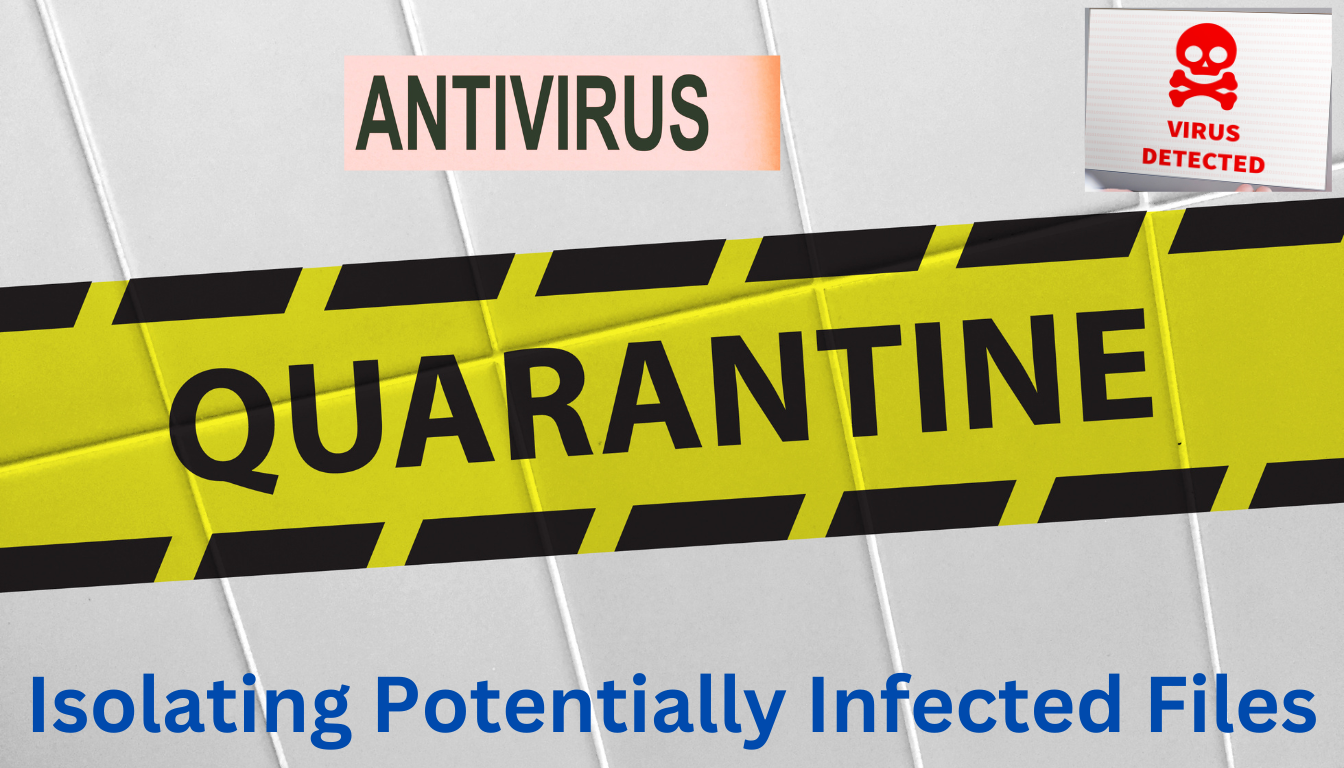Introduction
Antivirus quarantine is an essential feature of virus protection software that plays a vital role in safeguarding your computer. By isolating potentially infected files, it prevents them from causing harm and ensures the overall security of your system. In this article, we will dive into the intricacies of antivirus quarantine mechanism, explaining how it works and why it is crucial for your computer’s well-being.
Points To Note:
- Antivirus quarantine is a fundamental component of virus protection software.
- It isolates potentially infected files to prevent them from harming your computer.
- Passive and active scanning are two methods employed by antivirus software to detect threats.
- When a file is quarantined, it is separated from the rest of your system to prevent contamination.
- Regularly reviewing and removing infected files from quarantine is recommended.
Table of Contents
History of Antivirus Quarantine
The concept of antivirus quarantine plays a pivotal role in the cybersecurity landscape, serving as a crucial line of defense in protecting digital environments from potential threats. Understanding the history of antivirus quarantine provides insights into its development and its importance in the ongoing battle against malware. This journey through the evolution of quarantine mechanisms not only highlights technological advancements but also underscores the innovative approaches to digital safety.
The Early Days of Digital Security
In the early stages of computer virus outbreaks, the primary method of dealing with detected malware was straightforward deletion. However, this approach often posed risks, including the loss of important data and the potential for false positives—legitimate files mistakenly identified as malicious.
Introduction of Quarantine Concept
The concept of quarantine in antivirus software emerged as a sophisticated alternative to immediate deletion. By isolating suspicious files in a secure area of the computer, antivirus programs could prevent them from executing harmful actions while allowing users to review these files. This development marked a significant leap in digital security, offering a safer way to manage detected threats.
Advancements in Quarantine Mechanisms
Over the years, antivirus quarantine mechanisms have become more advanced, incorporating features such as automatic analysis and repair of infected files. Modern antivirus solutions now employ a variety of techniques to determine the best course of action for quarantined items, including deletion, repair, or user review.
The Role of Cloud Computing

The integration of cloud computing with antivirus quarantine has further enhanced its effectiveness. By leveraging cloud-based databases and analysis tools, antivirus programs can more accurately identify threats and reduce false positives, ensuring that only genuine threats are quarantined.
Quarantine in Today’s Cybersecurity Ecosystem
In today’s complex cybersecurity ecosystem, the quarantine function remains a critical component of antivirus software. It reflects the delicate balance between aggressive threat removal and the preservation of user data, embodying the principle of cautious yet effective threat management.
Meaning Of Quarantine
An antivirus quarantine is an essential component of computer security that aims to protect your system from infected files. When your antivirus software detects a file suspected of containing a virus, it places it in quarantine. By isolating these files from the rest of your computer, the risk of contamination and potential damage is minimized.
When a file is quarantined, it is moved to a secure location where it cannot interact with other files or processes on your computer. This prevents the virus from spreading and causing further harm. Quarantine also allows you to safely analyze the file and determine whether it is infected or a false positive.
During the quarantine period, the infected file remains in a controlled environment where it cannot execute or pose any threat to your system. This gives you the opportunity to take appropriate actions, such as deleting the file or restoring it if it is determined to be safe.
Importance of Quarantine

Antivirus quarantine is a critical aspect of computer security as it helps prevent the spread of malware and protects your system from potential damage. By isolating infected files, you can safely remove any threats and minimize the risk of further contamination.
Without antivirus quarantine, infected files could infect other files and compromise your computer’s security. They could also spread to other devices on your network or be transmitted to other users, potentially causing widespread damage.
Quarantine provides an added layer of protection by keeping infected files separate from your important data and system files. This allows you to safely clean and remove the threats without risking the loss of crucial information or disrupting the functionality of your computer.
Overall, antivirus quarantine plays a vital role in maintaining a secure computing environment and safeguarding your digital assets. It is an essential feature that every computer user should leverage to ensure their computer’s security and prevent the potential harm caused by infected files.
Pros and Cons of Quarantine
| Pros of Antivirus Quarantine | Cons of Antivirus Quarantine |
|---|---|
| Prevents Immediate Spread: Quarantining a suspected file stops it from executing and potentially spreading malware to other parts of the system. | Delayed Decision Making: Sometimes, the decision on whether to delete, repair, or restore a quarantined file can be delayed, leaving potentially harmful files in limbo. |
| Allows for Analysis: Quarantined items can be analyzed in a safe environment to determine if they are truly malicious without risking system integrity. | User Intervention Required: Some quarantined files may require user intervention to decide their fate, which can be cumbersome for users without technical knowledge. |
| Reduces False Positives: By not immediately deleting detected files, quarantine reduces the risk of accidentally removing important, non-malicious files. | Potential Security Risk: If not managed properly, quarantined files might still pose a security risk, especially if they are not completely isolated or if the quarantine area is compromised. |
| Facilitates File Recovery: If a file is wrongly quarantined, it can be easily restored to its original location without data loss. | Storage Space: Quarantined files take up storage space, which can become significant if many files are quarantined and not reviewed regularly. |
| Educational Tool: Reviewing quarantined items can educate users about potential threats and safe computing practices. | Overreliance on Software Judgment: Users might rely too heavily on the antivirus software to make the right decision, potentially overlooking the importance of safe browsing habits and updates. |
Understanding How does antivirus software work?

Antivirus software plays a crucial role in protecting your computer from potential threats. It operates through passive scanning and active scanning methods, offering various scanning options to ensure comprehensive protection.
Passive Scanning
In passive scanning, antivirus software continuously monitors your computer for any suspicious activity or files in the background. It automatically scans incoming files or programs for malware or viruses without requiring any manual intervention from you. This real-time protection helps prevent potential threats from infecting your system, ensuring your computer’s ongoing security.
Active Scanning
Active scanning, on the other hand, involves manually initiating a scan or configuring the software to scan specific files or directories. This process enables the antivirus software to perform a more thorough evaluation of your computer’s files. Active scanning can be particularly useful when you suspect specific folders or files may be infected or when you want to conduct a routine checkup on your system.
During the scanning process, antivirus software analyzes each file based on various factors, such as file size, behavior, and known virus signatures. It compares the files against an extensive database containing information about known viruses and malware, allowing it to identify potential threats. Depending on the software settings, it may choose to automatically send infected files to quarantine or prompt you for further action.
Antivirus software settings and features can vary depending on the specific program you use. Some software allows you to customize the scanning process, adjusting the level of aggressiveness and the areas to be scanned. Common scanning options include basic scans, which focus on critical areas, and full scans, which thoroughly examine all files on your computer.
| Scanning Method | Description |
|---|---|
| Passive Scanning | Continuous monitoring for potential threats in the background without user intervention. |
| Active Scanning | Manually initiated scan or scheduled scan to evaluate specific files or directories. |
| Basic Scan | Focuses on critical areas of your computer, providing a quick assessment. |
| Full Scan | Thoroughly examines all files on your computer for maximum protection. |
| Infected Files | Files detected as containing malware or viruses during the scanning process. |
| Software Settings | Customizable options for adjusting scanning preferences and aggressiveness. |
Outcome when you quarantine a virus?
When a virus is quarantined, it undergoes a specific process to ensure that it is no longer a threat to your computer. This process involves deleting the infected file from its original location and modifying it so that it cannot run as a program. The quarantined file is then transferred to a hidden folder that is inaccessible to other programs or users.
By moving the infected file to a hidden folder, it is effectively isolated from the rest of your computer, preventing it from causing any harm. This isolation is crucial in maintaining the overall security of your computer and protecting it from any potential threats.
In addition to automatically quarantining viruses, you also have the option to manually quarantine suspicious files that may not have been detected during an antivirus scan. This provides an extra layer of protection and allows you to ensure the safety of your computer.
When Files are Infected

While using antivirus software to quarantine infected files is generally safe, there is a slight risk of false positive detections or unintentionally quarantining important system files. It is important to regularly review and clean your quarantined files to prevent any potential data loss.
Infected files that are placed in quarantine do not pose an immediate danger to your computer’s security. However, they can take up valuable storage space, which can impact your computer’s overall performance. It is therefore recommended to take appropriate action, such as deleting or cleaning infected files, to maintain optimal computer safety.
| Concerns | Solutions |
|---|---|
| Data Loss | Regularly review and clean quarantined files to prevent any potential loss of important data. |
| Clean Quarantine Files | Remove unnecessary files from quarantine to free up storage space and optimize your computer’s performance. |
| Delete Infected Files | Take appropriate action to delete infected files and prevent any further harm to your computer. |
| Computer Safety | Ensure the safety of your computer by regularly monitoring and managing infected files. |
Do certain antivirus programs perform the process more efficiently?
Different antivirus programs offer varying capabilities when it comes to threat detection, malware removal, and ransomware protection. While all antivirus software aims to safeguard your computer, some may be more efficient at detecting specific types of threats, such as spyware or phishing attacks. To ensure comprehensive protection, it is recommended to use a combination of antivirus and anti-malware software.
By utilizing both types of software, you can enhance your defense against a wide range of threats and minimize the risk of infection. Antivirus programs specialize in detecting and eliminating viruses, while anti-malware software focuses on identifying and removing different forms of malicious software. By employing a multi-layered approach, you can significantly strengthen your computer’s security.
Furthermore, regularly updating your antivirus software is crucial to stay informed about the latest threats and vulnerabilities. Cybercriminals are continually developing new methods to bypass security measures, and antivirus updates often include patches and enhancements to combat these evolving threats. By keeping your antivirus software up to date, you can proactively protect your system from emerging dangers.
Conclusion
The antivirus quarantine mechanism stands as a crucial layer in the multifaceted defense strategy against malware and cyber threats. By effectively isolating suspicious files, it serves a dual purpose: preventing potential threats from causing harm while affording users the opportunity to examine and decide the fate of these files. This approach mitigates the risk of automatic deletion of important documents that may have been falsely flagged as malicious, thereby preserving valuable data.
Quarantine’s significance is further highlighted by its evolution over time, from a simple isolation technique to an advanced system integrated with cloud computing and heuristic analysis. This progression not only enhances the accuracy of threat detection but also reduces the instances of false positives, ensuring that legitimate software is not unjustly penalized.
However, the effectiveness of an antivirus quarantine mechanism is not solely reliant on its technological prowess but also on the user’s vigilance and understanding. Regular review and management of quarantined items are essential to maintaining system integrity and security. Users must stay informed about the latest threats and understand how to respond to notifications from their antivirus software.
In conclusion, the antivirus quarantine mechanism exemplifies a balanced approach to cybersecurity, striking a harmony between aggressive malware removal and the preservation of user data. As cyber threats continue to evolve, so too will quarantine technologies, adapting to new challenges and safeguarding digital spaces with even greater efficacy. The future of digital security will undoubtedly see further innovations in quarantine mechanisms, reinforcing their role as an indispensable tool in the antivirus arsenal.



